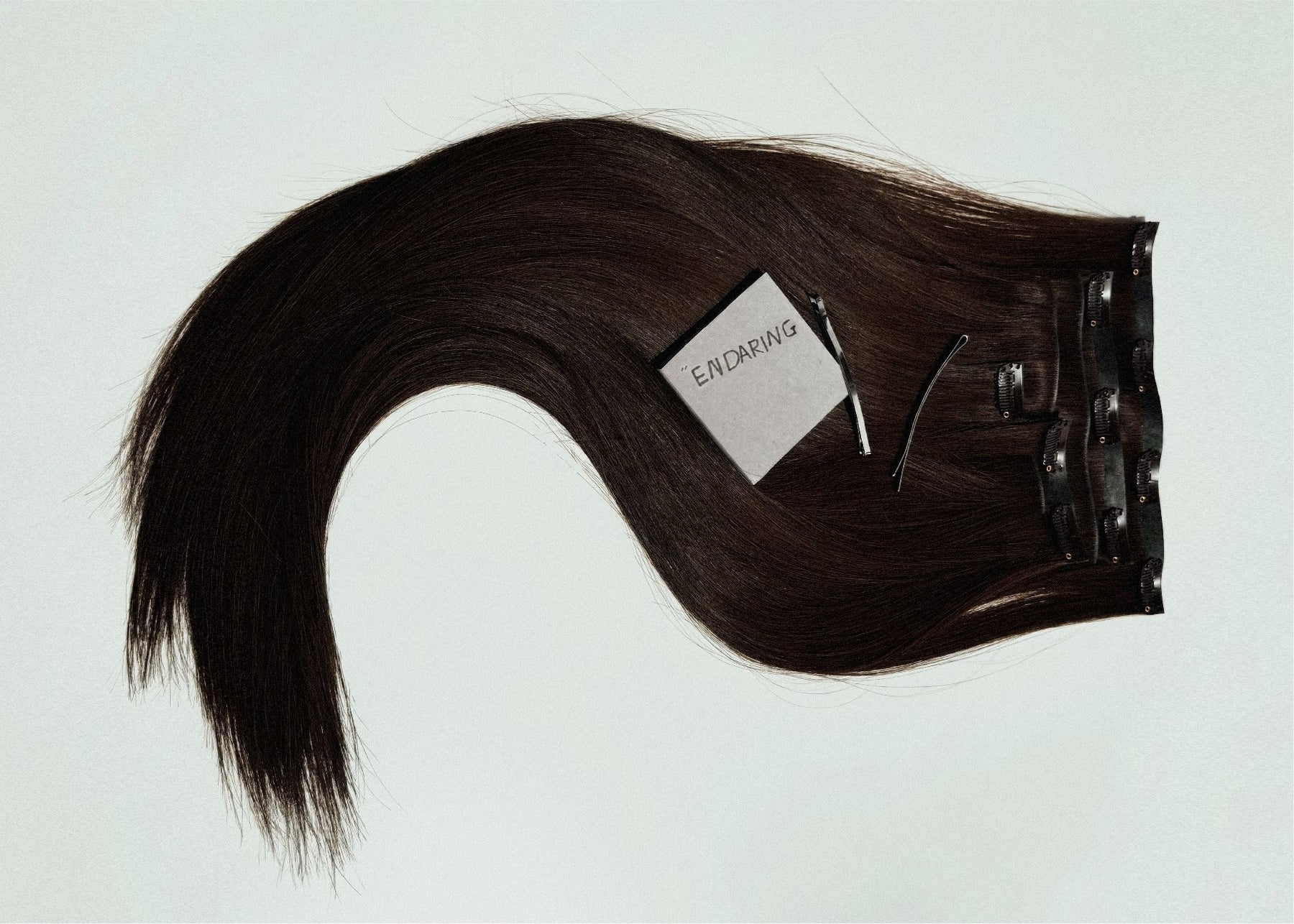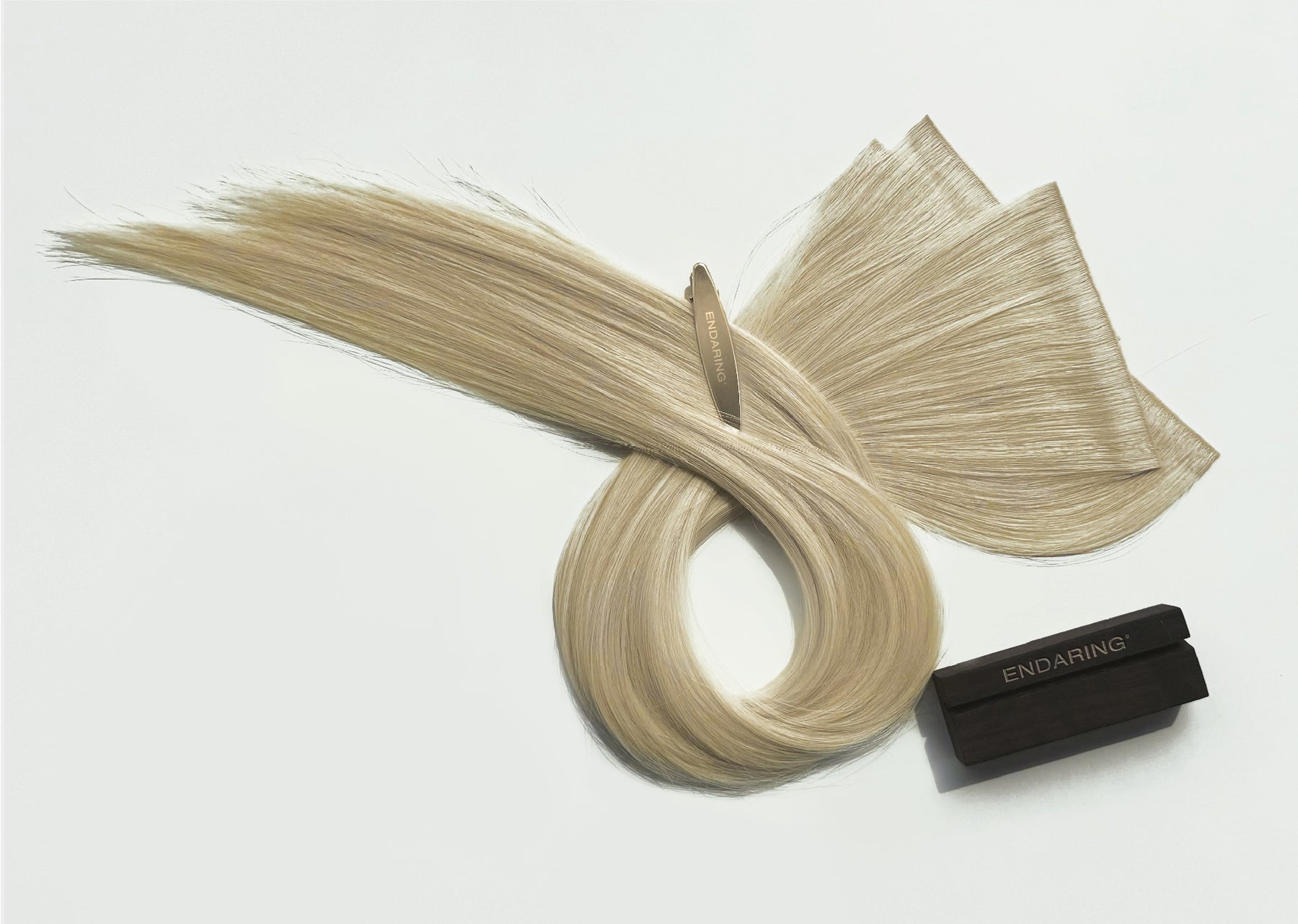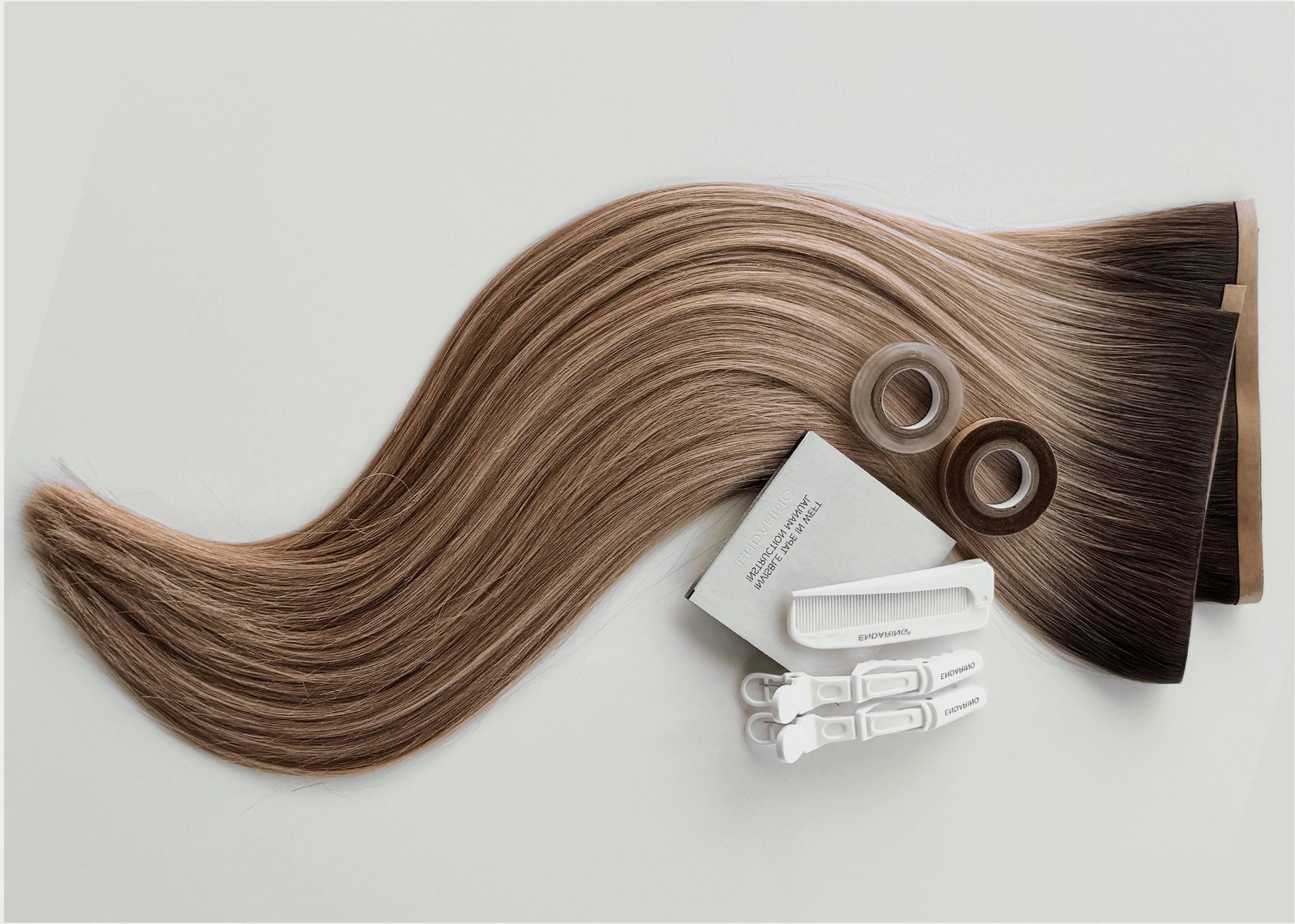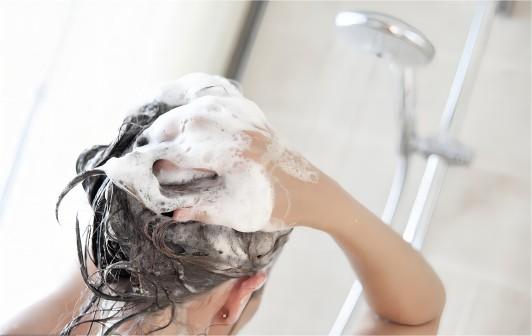Welcome to the world of hair care, where split ends are the sneaky little troublemakers that can disrupt the tranquility of your luscious locks. Today, we're embarking on a journey to decode the secrets of split ends versus healthy hair.

Healthy Hair Characteristics:
Healthy hair is more than just the absence of split ends;- Natural Shine: Healthy hair naturally shines and reflects light. This shine is a direct result of the smooth and intact cuticle layer. When the cuticle is healthy and lies flat, it acts as a mirror, allowing light to bounce off the hair's surface. The result is hair that looks lustrous and radiant.
- Good Elasticity: Elasticity is a critical characteristic of healthy hair. It means that the hair can stretch without breaking. When you gently pull a strand of healthy hair, it should have some give and return to its original state without snapping. This elasticity is a clear indicator of good moisture balance and overall hair health.
- Strength and Resilience: Healthy hair is strong and resilient. It can withstand daily wear and tear, including brushing, heat styling, and environmental stressors. Strong hair is less likely to break or develop split ends, which contributes to its overall durability.
- Moisture Balance: Maintaining a proper moisture balance is essential for healthy hair. Hair that's too dry becomes brittle and is prone to damage, while hair that's overly moist can become weak and lackluster. Healthy hair strikes a balance, retaining enough moisture to stay flexible and vibrant.
- Texture and Softness: Healthy hair is soft to the touch and has a pleasant texture. It should feel smooth and silky when you run your fingers through it. This softness is a result of the intact cuticle layer, which prevents friction and tangling.
- Manageability: Healthy hair is easy to manage and style. It cooperates when you're styling, whether you're straightening, curling, or putting it up in a bun. It's less prone to frizz and maintains its shape well.
- Minimal Breakage: A key characteristic of healthy hair is minimal breakage. When you comb or brush it, you won't see an excessive number of broken strands in your hairbrush. Healthy hair remains intact during daily grooming.
- Color Vibrancy: For those with colored hair, healthy hair retains its color vibrancy. When hair is healthy, it holds onto color more effectively, resulting in longer-lasting and more vibrant hues.
 *Healthy Hair Ends
*Healthy Hair Ends
Understanding Split Ends:
Trichoptilosis - The Scientific Term: Split ends are formally known as "trichoptilosis." This term breaks down to "tricho" meaning hair and "ptilosis" meaning splitting. Knowing the scientific name adds a layer of understanding to this common hair woe.
The Hair Cuticle - Your Hair's Protector: The outermost layer of your hair, called the cuticle, is like a protective shield. It consists of overlapping scales, akin to the shingles on a roof. When this cuticle becomes damaged, it disrupts the hair's natural defense mechanism.
Structural Compromise: When the cuticle scales are intact, they keep the hair shaft sealed, locking in moisture and maintaining strength. However, various factors can lead to the cuticle's damage, causing it to lift and expose the inner cortex.
How Split Ends Form: As the cuticle lifts or breaks, the inner cortex of the hair becomes exposed and vulnerable. This leads to the formation of split ends, where the hair strand literally splits into two or more fragments. These split ends can travel upward along the hair shaft if not dealt with promptly.
Universal Problem: It's essential to emphasize that split ends can affect anyone, regardless of hair type, texture, or length. This is a concern that spans across the entire spectrum of hair types, from fine and straight to thick and curly.
Aesthetic Impact: One of the most visible consequences of split ends is the change in the hair's appearance. Split ends can make hair look frizzy, unmanageable, and unkempt. They also reduce the hair's overall shine and can give it a dull, lackluster appearance.
Detecting Split Ends: In this section, we'll guide readers on how to spot split ends in their own hair.

Certainly, let's provide specific details on how to detect split ends in this section:
-
Y-Shaped Ends: One of the most recognizable signs of split ends is their Y-shaped appearance. When you inspect the tip of a strand of hair, you'll notice that it has split into two or more separate sections, resembling the shape of the letter Y. This distinctive shape is a clear indication of split ends.
-
Uneven or Frayed Ends: Split ends can also manifest as uneven or frayed ends. Instead of a clean and uniform cut, the ends of your hair may appear jagged, with some strands sticking out in different directions. This unevenness is a sign of damage to the hair cuticle.
-
Tiny White Dots: Another way to detect split ends is by looking for tiny white dots at the tips of your hair. These dots are actually the exposed, weakened inner cortex of the hair shaft. They indicate that the protective cuticle layer has been compromised, leaving the hair vulnerable to further damage.
-
Rough Texture: Run your fingers down the length of your hair. If you encounter a rough or coarse texture on certain strands, it's likely that you're feeling split ends. Healthy hair should feel smooth and sleek, while split ends feel rough to the touch.
-
Increased Tangling: Hair with split ends tends to tangle more easily than healthy hair. If you find that your hair is becoming knotted or tangled frequently, it could be due to split ends. These damaged ends catch onto other strands, leading to tangles and knots.
-
Lackluster Appearance: Split ends can make your hair look lackluster and dull. If you've noticed that your hair has lost its natural shine and appears frizzy or lifeless, it may be an indication of split ends.
-
Increased Breakage: Split ends weaken the hair, making it more prone to breakage. If you're experiencing an increase in hair breakage or noticing more broken strands in your brush or on your pillow, it's a sign that split ends may be present.
The Science Behind Split Ends:
Understanding the science behind split ends is crucial for taking effective action.
-
Structural Integrity of Hair: Hair is composed of three main layers - the cuticle, the cortex, and the medulla. The outermost layer, the cuticle, plays a crucial role in protecting the inner layers. It consists of tiny, overlapping scales or shingles that cover the hair shaft.
-
Cuticles as the Hair's Defense: These cuticles act like armor, guarding the inner cortex of the hair. They serve two critical purposes: keeping moisture inside the hair and shielding it from external damage, such as UV rays, pollutants, and friction.
-
Weakening of Cuticles: Various factors can compromise the integrity of these cuticles. Heat styling tools like flat irons or curling wands, for instance, can expose hair to high temperatures, causing the cuticles to lift. Harsh chemical treatments, like bleaching or perming, can also strip away the cuticle's protective layer.
-
Environmental Stressors: Environmental stressors, such as excessive exposure to sunlight, extreme temperatures, and dry air, can weaken the cuticles over time. Prolonged exposure to these elements can make hair more susceptible to damage.
-
Result: Vulnerable Hair Shaft: When the cuticles are damaged, the inner cortex of the hair becomes exposed. This exposure weakens the hair strand, making it more likely to split or break. Think of it as a house with a damaged roof; once the protective layer is compromised, the interior becomes vulnerable to harm.
-
Visualizing the Phenomenon: To help readers grasp the concept better, we can use analogies or visuals. For instance, we can liken the cuticles to the scales on a fish, and when those scales are lifted, the fish's delicate skin becomes exposed. This analogy makes it easier for readers to understand how the hair's protective layer is compromised.
The Culprits of Split Ends:
To prevent split ends effectively, we must identify the causes. It's essential to uncover the culprits responsible for split ends.
-
Excessive Heat Styling: Heat-styling tools like flat irons, curling wands, and blow dryers are common culprits in the formation of split ends. The high temperatures can weaken the cuticle, making it more susceptible to damage. It's crucial to use these tools in moderation and with proper heat protectants to minimize the risk of split ends.
-
Aggressive Brushing: Brushing or combing your hair vigorously, especially when it's wet, can lead to split ends. Wet hair is more fragile, and aggressive brushing can cause the hair shaft to weaken and break. Opt for wide-toothed combs or brushes with soft bristles and be gentle, especially when detangling wet hair.
-
Chemical Treatments: Chemical processes like hair coloring, bleaching, perming, and relaxing can strip the hair of its natural protective layer. This makes it more prone to split ends and damage. If you regularly undergo chemical treatments, it's essential to provide extra care and use products specifically designed for chemically treated hair.
-
Environmental Factors: Environmental elements, such as sun exposure and dry air, can also contribute to split ends. UV rays from the sun can damage the cuticle, while dry air can sap moisture from the hair, leaving it brittle. Wearing a hat or using products with UV protection can help shield your hair from the sun's harmful effects, and using a humidifier can combat the drying effects of indoor heating in dry climates.
-
Over-Shampooing: Shampooing your hair too frequently can strip away natural oils that protect the hair and maintain its moisture balance. Over time, this can lead to dry, brittle hair that is more prone to split ends. Finding the right shampooing frequency for your hair type is essential.
-
Tight Hairstyles: Wearing tight hairstyles like braids, ponytails, or buns frequently can cause stress on the hair shaft. This stress can lead to breakage and the development of split ends along the hairline. Opt for looser styles or give your hair breaks between tightly styled days.
-
Lack of Moisture: Insufficient hydration can make hair more vulnerable to split ends. Ensure you're drinking enough water, and use moisturizing hair products to maintain your hair's moisture balance.
-
Inadequate Nutrition: Your diet plays a significant role in the health of your hair. A lack of essential nutrients, particularly proteins, vitamins, and minerals, can result in weak and brittle hair. A balanced diet rich in these nutrients is crucial for overall hair health.
Preventive Measures:
Prevention is often the best approach to dealing with split ends.
Certainly, let's provide more specific details on preventive measures to tackle split ends effectively in this section:
-
Use Heat Protectants: When heat-styling your hair, always use a heat protectant spray or serum. These products create a barrier between your hair and the high temperatures of styling tools, minimizing damage to the cuticle and the risk of split ends.
-
Adjust Heat Settings: When using heat styling tools, like flat irons or curling wands, avoid the highest heat settings if they're not necessary. Lower temperatures can achieve the desired results with less damage to the hair.
-
Limit Heat Styling: Reduce the frequency of heat styling to protect your hair. Consider embracing your hair's natural texture or opting for heatless styling methods on some days.
-
Avoid Tight Hairstyles: Give your hair a break from tight hairstyles that cause stress on the hair shaft. Opt for looser, gentler styles, and use soft hair ties or scrunchies to prevent breakage.
-
Trim Regularly: Regular trims every 6-8 weeks help prevent split ends from traveling up the hair shaft. It's an essential part of maintaining healthy hair.

-
Condition and Moisturize: Use a good-quality conditioner every time you shampoo to maintain moisture and strengthen your hair. Occasional deep conditioning treatments can further enhance moisture balance.
-
Gentle Detangling: Be gentle when detangling wet hair, as it's more susceptible to damage. Start at the tips and work your way up, using a wide-toothed comb or a detangling brush.
-
Avoid Excessive Chemical Treatments: Minimize the use of harsh chemical treatments like bleaching, perming, or relaxing. If you must use them, consult a professional and follow up with proper aftercare to minimize damage.
-
Protect Your Hair from the Sun: Use hair products with UV protection, wear a hat, or cover your hair with a scarf when exposed to the sun to shield it from UV damage.
-
Maintain a Balanced Diet: Ensure your diet includes a variety of nutrients, including proteins, vitamins, and minerals, to support healthy hair growth and strength.
-
Use Satin or Silk Pillowcases: Switch out your cotton pillowcase for a satin or silk one. These materials reduce friction and help prevent hair damage while you sleep.
-
Proper Hair Drying: Avoid aggressive towel-drying, which can lead to hair breakage. Instead, gently pat your hair with a microfiber towel or an old t-shirt to remove excess water.
Hair Care Routine for Split Ends:
Creating a comprehensive hair care routine is a proactive way to combat split ends.
-
Gentle Shampooing: Choose a sulfate-free, mild shampoo that suits your hair type. Avoid daily shampooing, as it can strip your hair of natural oils. Aim to shampoo every 2-3 days to maintain a balance between cleanliness and moisture retention.
-
Conditioning: Use a high-quality conditioner every time you shampoo. Apply it primarily to the mid-lengths and ends of your hair, which tend to be drier. Leave the conditioner on for a few minutes before rinsing to allow it to penetrate and moisturize your hair thoroughly.
-
Cold Rinse: Finish your shower with a cold water rinse. Coldwater helps seal the hair's cuticle, keeping it smooth and less prone to damage. It also enhances shine.
-
Weekly Hair Mask: Incorporate a nourishing hair mask into your routine once a week. Choose a mask that addresses your hair's specific needs, whether it's for hydration, repair, or strengthening. Apply the mask from roots to ends, leave it on for the recommended time, and then rinse thoroughly.
-
Avoid Hot Water: While showering, use lukewarm or cool water to wash your hair. Hot water can strip your hair of essential oils, making it more susceptible to damage.
-
Air-Drying: Whenever possible, let your hair air-dry instead of using a blow dryer. If you must use a dryer, opt for the lowest heat setting and keep it at a safe distance to minimize heat damage.
-
Use Wide-Toothed Comb: After washing your hair, use a wide-toothed comb to detangle gently. Start from the tips and work your way up, reducing the risk of breakage.
-
Protective Styling: On days when you want to keep your hair off your face, choose loose and protective hairstyles that don't cause stress on your hair. Using soft hair ties or scrunchies can also prevent breakage.
-
Regular Trims: Don't skip your regular trims. Visit a professional stylist every 6-8 weeks to remove split ends and maintain the health of your hair.
-
Nutrition and Hydration: Stay hydrated by drinking enough water, and ensure your diet includes a variety of nutrients that support hair health. Protein, vitamins, and minerals are essential for strong and healthy hair.
-
Sleep on Silk or Satin: Swap your cotton pillowcase for a silk or satin one. These materials cause less friction, preventing hair damage while you sleep.
DIY Remedies for Split Ends:
Not everyone can rush to the salon every time they spot split ends. DIY remedies can be a great alternative. We'll share natural, at-home treatments and masks that can help repair split ends and improve hair texture. These remedies are easy to prepare and use, making them accessible to anyone seeking to restore their hair.
Rice Water Rinse: Rinse your hair with the water used to rinse rice. Rice water contains amino acids and vitamins that can strengthen and improve the texture of your hair. Leave it on for 10-15 minutes, then rinse with cool water.
Beer Rinse: Beer can add shine and body to your hair. After shampooing, pour a small amount of beer over your hair, leave it on for a few minutes, and rinse with water to remove the smell.
Papaya and Honey Mask: Blend papaya and mix it with honey to create a mask. Apply it to your hair, leave it on for 30 minutes, and then rinse. Papaya is rich in vitamins and enzymes that can promote hair health.
Olive Oil and Rosemary: Mix a few drops of rosemary essential oil with olive oil. Apply this mixture to your hair, focusing on the ends. Leave it on for about 30 minutes and then wash it out. Rosemary oil can stimulate hair growth, while olive oil adds moisture.
Shea Butter Treatment: Warm up shea butter and apply it to the ends of your hair. Leave it on for about 30 minutes and then wash it out. Shea butter provides deep conditioning and helps repair damaged hair.
Trimming Myths and Facts:
Myth: Trimming Hinders Hair Growth- Fact: Regular Trims Promote Growth: One of the most common misconceptions is that trimming your hair will slow down its growth. In reality, getting regular trims is essential for maintaining healthy, long hair. When you trim your hair, you're removing split ends and preventing them from traveling up the hair shaft. This, in turn, reduces the need for more significant haircuts down the line, allowing your hair to grow longer and healthier.
Myth: My Hair Doesn't Need Trims if I Don't Have Split Ends
- Fact: Trims Prevent Split Ends: Waiting for split ends to become visible before getting a trim can lead to more extensive damage. Trims are not just about addressing existing split ends; they are a preventive measure to stop them from occurring in the first place. By regularly trimming your hair, you maintain the integrity of the hair shaft, preventing split ends from forming.
Myth: I Can Trim My Hair Myself
- Fact: Professional Trims Are Best: Some individuals attempt to trim their hair at home to save money. While this can work for minor touch-ups, it's generally recommended to visit a professional stylist for trims. They have the expertise to ensure an even, balanced cut and can identify any potential issues with the hair that might require special attention.
Myth: Trims Are Always About Cutting Length
- Fact: Trims Can Be Minimal: Trims don't always mean losing significant length. In many cases, trims can be minimal, involving the removal of only a fraction of an inch. This helps maintain the hair's health without drastically altering its appearance.
Myth: Hair Grows From the Ends
- Fact: Hair Growth Happens at the Scalp: Hair doesn't grow from the ends; it originates from the hair follicles in your scalp. Trimming the ends doesn't affect the hair's growth rate; it affects the hair's overall health and appearance.
Myth: I Don't Need Trims Because I Have Short Hair
- Fact: All Hair Lengths Benefit: Whether you have short or long hair, regular trims are essential. Short hair can still develop split ends, and trims help keep it looking neat and healthy.





